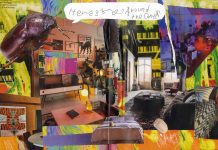
Hake stands at one of the highest points in Brussels, which overlooks the city.
By Maggie Hake
Eating abroad has been a thoroughly ridiculous/mostly delicious experience (or sometimes experiment).
Grocery shopping in Leiden is one of my favorite things. There are a few large grocery stores all in walking or biking distance from the dorms. A lot of study-abroads and I frequent Jumbo (pronounced yum-bo) for a plethora of our grocery needs. There are fewer options at the grocery stores than there are in the U.S., but most items you could want are available. Living in Europe, I have not only learned to live with fewer options, but I’ve learned to actually like it.
The first day we went to the grocery store upon arriving in Leiden, we had no idea what to buy or how to feel (probably jet-lag induced) and ended up leaving with things we didn’t even eat on a regular basis. Also, we didn’t get the bag-your-own-groceries memo, so we showed up confused and bag-less.
After some experimentation and purchasing of products that were not what I thought they’d be (all of the labels are in Dutch), I can now purchase pasta sauce without weird ham in it (ew) and choose a milk carton that actually contains milk rather than yogurt. It’s easy to be drawn to American brands out of comfort and familiarity, but this is a sure way to spend more than necessary, because American brands are always pricier.
Another thing we have to factor into our budget is the euro-to-dollar conversion rate, which is around $1.39 to every euro. This means we have to factor extra into our budget since we’re spending a little more U.S. dollars on items than it seems.
Another popular (and inexpensive) place to shop in Leiden is the market, which is set up Wednesdays and Saturdays from 9 a.m. to 5 p.m. I usually buy everything I can at the market and then buy supplemental groceries at a grocery store. You can find deals like two mangos for one euro or 20 clementines (yeah, 20) for two euros. They sell fresh cheese, fish, olives, hummus and freshly squeezed orange juice, so this is the go-to place for all things produce. There are some other items you can pick up at the market as well, such as trinkets, clothing, candles and toiletries. They also sell fresh Dutch foods, like vlaasme frites, which are homemade fries with special mayonnaise, and homemade stroopwafels, two thin doughy waffles with a caramel syrup inside.
Overall, the market is a great way to feel immersed in Leiden. I love having an inexpensive and local option; it’s a great way to try fresh Dutch foods and a really relaxing way to spend a Wednesday morning before class.
Although there’s no on-campus dining option at Webster Leiden, there are countless places within walking distance from the school where you can grab a bite to eat between classes or on the weekends. Snackbar is a favorite—they have amazing gyros, delicious Doner kebabs, cheese soufflés called kassoufle, and the most incredible pistachio milkshake I’ve ever tasted. There’s also a Domino’s pizza and McDonald’s if you like familiarity, a Bagels and Beans which sells coffee, smoothies, and delicious bagel sandwiches, some sushi places, an Italian restaurant, and some other convenience stores. They’re not technically on campus but they might as well be; none of them are more than a five minute walk from campus.
As far as eating while traveling, it can be a little expensive. I try to stick with splurging on food that is authentic to the area I’m visiting. Some treat-yourself dishes include seafood paella in Barcelona, traditional Dutch pea soup in Amsterdam, Guinness stew and bangers and mash in Ireland, fish and chips in London, and, of course, Belgian waffles and beer in Brussels.
If you are planning to study abroad, justify in your mind (and budget) now that food is part of the cultural experience you’re meant to have while abroad, so you can try things guiltlessly.



